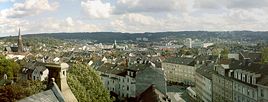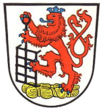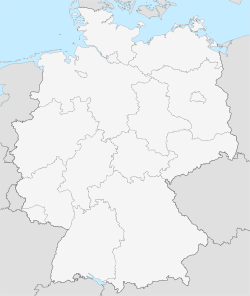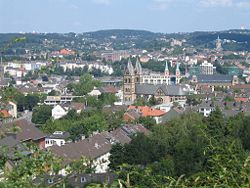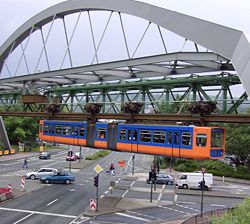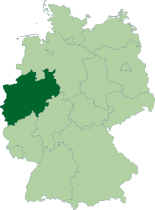Wuppertal
|
||||||||||||||||||||||||||||||||||||||||||||
|
||||||||||||||||||||||||||||||||||||||||||||
Wuppertal (IPA: [ˈvʊpɐtaːl]) is a city in North Rhine-Westphalia, Germany. It is located on the Wupper river south of the Ruhr area. Population 361,333 (2005).
Two thirds of the total municipal area is green belt: woods, meadows, gardens and fields. From any part of the city it is only a ten-minute walk to one of the public parks or shady woodland path. At the same time it is a major industrial centre including such industries as: textiles, metallurgy, chemicals, medicine (Bayer), electric, rubber, vehicles and printing equipment. One of the most famous pain-killers, Aspirin, was invented in Wuppertal by Bayer.
Contents |
History
The city was formed in 1929 by merging Barmen, Elberfeld, Vohwinkel, Ronsdorf, Cronenberg, Langerfeld, and Beyenburg. The name was initially Barmen-Elberfeld, and after 1930 Wuppertal (“Wupper Valley”). The new city was administered within the Prussian Rhine Province.
Uniquely for Germany it is a linear city, owing to the steep hillsides along the river Wupper. The dominating city-centres Elberfeld (historic commercial centre) and Barmen (more industrial) form a united built-up area since 1850. In the following decades, this “Wupper-Town” became the dominating industrial agglomeration of the territories in northwestern Germany. Before the 19th century ended, this conurbation had been surpassed by Cologne, Düsseldorf and the Ruhr area, all with much more favourable topography.
During World War II, it was destroyed to about 40% by the Allies as were many other industrial centres at the time. However, a large number of historic sites have been preserved, such as
- Ölberg (“Oil Hill”), Germany’s largest working class district, protected as a historic monument. The name accrued in the 1920s by the matter of fact, that the surrounding bourgeois residential quarters already had electric light, while this district still used oil lamps.
- Brill, one of Germany’s largest districts of Gründerzeit-villas, what means lordly bourgeois mansions, built in the second half of the 19th century.
After the liberation from the Nazi regime, Wuppertal became a part of the British Occupancy Zone, and subsequently a part of the new state North Rhine-Westphalia in West Germany.
Main sights
In total, Wuppertal possesses over 4,500 buildings classified as national monuments, most dating from styles as Neoclassicism, Eclecticism, Historicism, Art Nouveau/Jugendstil and Bauhaus.
Main sights include:
- Concert hall, a fine masterpiece of turn-of-the-century architecture (Stadthalle),
- Wuppertal Dance Theatre (Tanztheater Wuppertal), headed by Pina Bausch, is world-famous,
- Engels house (Engelshaus), architecturally typical of the region. It houses a permanent display of materials associated with Friedrich Engels and other famous citizens of Wuppertal,
- Wuppertal Zoo, one of the largest, most nicely landscaped zoos in Germany with many rare animals,
- Von der Heydt Museum, one of the most important galleries in Germany, with works by 19th and 20th century artists. The first of Picasso’s works that ever appeared in public was displayed here.
Schwebebahn
One of the city’s greatest attractions is the suspended monorail (“Wuppertaler Schwebebahn”), which was established in 1901. The tracks are 8 m above the streets and 12 m above the Wupper river.
Wuppertal in the arts
- The play, Die Wupper, by Else Lasker-Schüler takes places in Elberfeld.
- The 2000 movie, The Princess and the Warrior by Tom Tykwer, was filmed in Wuppertal.
- In the 1974 Wim Wenders film Alice in the Cities, the main characters visit Wuppertal.
Noted Wuppertal people
- Friedrich Bayer, founder of the Friedrich Bayer paint factory that later became Bayer AG
- Arno Breker, sculptor
- Rudolf Carnap, philosopher of science
- Udo Dirkschneider, singer in heavy-metal band Accept
- Friedrich Engels, philosopher, historian, co-author of the Communist Manifesto (with Karl Marx)
- Hans Knappertsbusch, orchestra conductor
- Else Lasker-Schüler, expressionist poet
- Harald Leipnitz, actor
- Ulrich Leyendecker, composer
- Reimar Lüst, astrophysicist
- Steffen Möller, satirist, soap-opera star and TV celebrity in Poland; the most popular German in Poland
- Tyron Montgomery, Oscar-winning film director
- Simone Osygus, swimmer
- Siegfried Palm, cellist
- Johannes Rau, former Federal President of Germany
- Alice Schwarzer, one of the leaders of the German feminist movement
- Sir Hans Wolfgang Singer, economist
- Rita Süssmuth, former President of the German Parliament
- Helmut Thielicke, theologian
- Tom Tykwer, film director (“Run Lola, Run”, “The Princess and the Warrior”), co-founder of X-Filme syndicate
- Günter Wand, orchestra conductor
- Sulamith Wülfing, artist and illustrator
- Peter Brotzmann and Peter Kowald, noted innovators in modern improvised music
- Christoph Maria Herbst, actor
- Hermann Ebbinghaus, psychologist who studied memory
Sister Cities
Wuppertal is twinned with:
 Beersheba, Israel
Beersheba, Israel Berlin-Tempelhof-Schöneberg, Germany
Berlin-Tempelhof-Schöneberg, Germany Košice, Slovakia
Košice, Slovakia Legnica, Poland
Legnica, Poland Matagalpa, Nicaragua
Matagalpa, Nicaragua Saint-Étienne, France
Saint-Étienne, France Schwerin, Germany
Schwerin, Germany South Tyneside, United Kingdom
South Tyneside, United Kingdom
|
||||||||||
